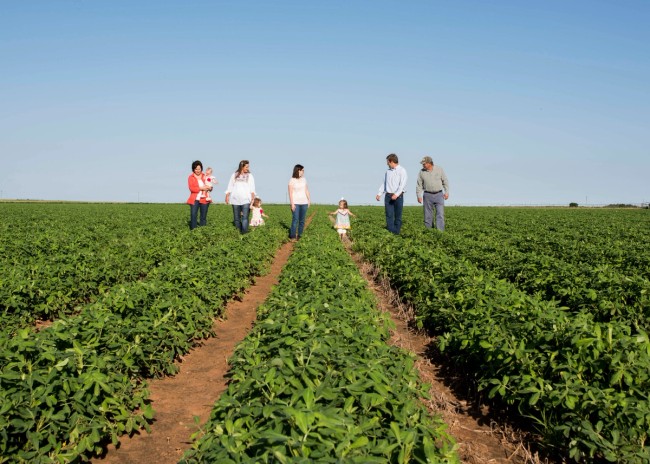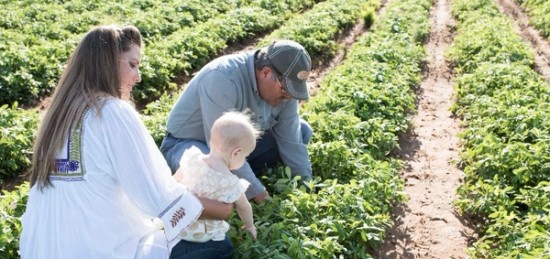Since 2007, the number of farms in the U.S. has steadily dropped, according to USDA1. In 2021, the estimated number was 2,012,050, down 6,950 farms from 2020. There could be a multitude of factors contributing to the decline of farming.
One common issue that could be turning future generations away is the financial risk associated with it. Greg Baltz is a peanut farmer from Arkansas and is the chair of NPB’s research committee. According to Baltz, older generations used to be able to help shield younger ones from the short-term risks associated with farming. However, this practice gets more complicated.
“As farms have gotten larger, the risks have gotten larger,” Baltz said. “The challenge is that every year you’re risking your whole net worth just to put in the next year’s crop. I think that’s what becomes the most challenging factor for me looking at young people coming forward onto the farm. That they may not be able to have the assets behind them to continue to be prosperous.”
According to the USDA, in 2020, the U.S. total farm expenditure average per farm was $182,130, up 2.6% from $177,564 in 20192. One of the factors contributing to the increasing costs of running a farm and thus the risk that Baltz refers to are rising input costs.
Austin White is a fifth-generation farmer from Oklahoma. He and his mom, Gayle, grow peanuts, cotton, corn, wheat, alfalfa and beef cattle. Austin says that these rising costs affect farmers the most.
“Farmers are one of the only producers that can’t pass the rise of costs to their consumers,” Austin said. “While input costs keep going up, our margins are being squeezed. If this trend continues, it will become hard for the average family farmer to make a living.”
One of the ways to help lower the risk is to look into the resources offered by the USDA, which offers programs for protection and recovery. You can find a list of their resources at farmers.gov/protection-recovery.
“Government programs are going to be essential going forward for young families to reduce a little risk to have some degree of certainty that one year cannot wipe them out,” Baltz said. “If there’s a disaster, there are resources to help build your programs back.”
Another common issue is the perceived lack of opportunities in small towns, including internet access. According to a study by PEW in 2021, 72% of rural Americans say they have broadband internet connection at home3.
While this is a 9-percentage point rise in home broadband adoption since 2016, it still means that close to 30% of rural Americans do not have internet access. Baltz says it’s things like that that contribute to farmer’s children forging their own careers off the farm.
“I think for my children, they saw access to just more opportunities that were available in the city than a small town or even a regional city,” Baltz said. “They all have gravitated to where they have so many more resources and I think they would have a hard time walking away from that.”
A final challenge that may be concerning future generations is the stress that comes with farming. Over the years mental health on the farm has become an increasingly urgent concern. The American Psychological Association even has a web page dedicated specifically to farm-related stress.
“The challenge for me and anyone else trying to get into farming is realizing that you don’t have to have control over all of the features of your business,” Baltz said. “You can be more controlled than the next guy. You can build infrastructure to help, but Mother Nature will still play its game and we have to learn how to deal with that. So, the advantages of farming work if you can learn how to manage stress, and, especially, try not to get stressed over the things you can’t control.”
In addition to the challenges, there are positives to raising a family on the farm. According to Gayle, the biggest positive was the work ethic it gave her children.

“I feel like raising kids on the farm was an absolute blessing,” Gayle said. “They learn first-hand what it takes to run a business. Work ethic is so important and farm life will teach a child how to work and be responsible.”
Another positive to working on the farm is it shows you how your food is made, thus giving you a better appreciation for what goes into your groceries.
“There is something special about having the opportunity to see something grow from a small seed to a large-scale product,” Austin said. “It’s unlike anything else. It’s also gratifying to know I can make a living doing something I love while providing our country with the safest quality food.”
Finally, for Baltz, raising a family on the farm allowed him to work close to home and get his kids involved with what he did for a living.
“It’s a great place to raise a family,” Baltz said. “We got the chance for the children to be outside and to be involved with my work, even when they were small children.”
While the number of farms does go down each year, the future is bright as long as we work to assuage the risks mentioned above and continue to encourage others to try their hand at farming.
References
- United States Department of Agriculture. (n.d.). Farms and Land in Farms. Economics, Statistics and Market Information System. Retrieved September 1, 2022, from https://usda.library.cornell.edu/concern/publications/5712m6524?locale=en
- United States Department of Agriculture. (2021, July). Farm Production Expenditures 2020 Summary. National Agricultural Statistics Service. Retrieved September 6, 2022, from https://www.nass.usda.gov/Publications/
- Vogels, E. A. (2021, October 19). Some digital divides persist between rural, urban and Suburban America. Pew Research Center. Retrieved September 6, 2022, from https://www.pewresearch.org/fact-tank/2021/08/19/some-digital-divides-persist-between-rural-urban-and-suburban-america/
